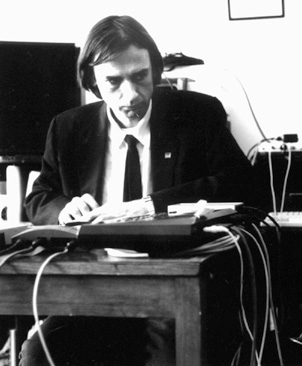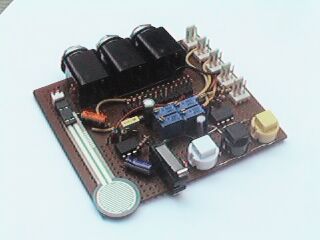This is not a piano
Rainer Linz
 The motivation to design and build a `new' musical instrument comes on the one
hand from a dissatisfaction with
existing instruments, and on the other from a desire to examine new ways of
making music, or "organising sound".
The motivation to design and build a `new' musical instrument comes on the one
hand from a dissatisfaction with
existing instruments, and on the other from a desire to examine new ways of
making music, or "organising sound".
I have designed other electronic and computer instruments, including the (dis)continuous music installation (1979) - a miniature gallery piece producing (and produced by) random bursts of noise. Others include a "score reading software instrument" (called ASP) designed to play analog synthesisers, and also real-time interactive sound systems used by the Australian performance artist Stelarc.
These instruments, unlike their traditional counterparts, were conceived as composing or listening tools, and were never designed for general use. The very personal nature of these instruments has tended to obstruct most forms of traditional musical performance - they were not designed to recreate music of the past and could not be used to do so. What is lost in backward compatibility is also gained by bringing new possibilities for creation.
In one important sense music has always been an interactive art, depending upon feedback between a performer and instrument. Indeed, there is a relationship here which is unique among the arts. Designing interactive instruments addresses a problem of interactive art generally, namely that musical systems are to be "played" and not simply "utilised". In other words, they must be learned.
 The instrument described here is an ongoing work in progress. It
can be described as a "manual
interface" consisting of switches as well as pressure, light and movement
sensors built onto a small circuit board, and
connected to a computer. In this way any real time performance on the switches
and sensors can be monitored by
the computer, and used to issue sound commands to a synthesiser.
The instrument described here is an ongoing work in progress. It
can be described as a "manual
interface" consisting of switches as well as pressure, light and movement
sensors built onto a small circuit board, and
connected to a computer. In this way any real time performance on the switches
and sensors can be monitored by
the computer, and used to issue sound commands to a synthesiser.
Any instrument using an array of switches to generate sound will inevitably invite comparisons with the piano and its keyboard. Yet this instrument, with it's reduced set of only four keys is more closely related to another keyboard, namely that of the personal computer. Like the PC keyboard, its keys have multiple functions depending on which of the others are depressed at the same time (as for instance in the shift key function on the PC). The design has required a new approach to keyboard performance technique.
Other sensors on the instrument are used to monitor hand gesture and control aspects of sound articulation. As the instrument develops it relies more heavily on aspects of the physical presence of the performer.
The sensor values created in performance are manipulated further by the
computer software, creating a complex
dialogue between the performer and instrument.
online links
other instrument designwork in progress
infonoise installation
barcode installation
movatar performance
brainscore performance
back to index page.
© 2001 Rainer Linz